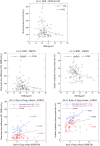Dosimetric evaluation of deep inspiration breath hold for left-sided breast cancer: analysis of patient-specific parameters related to heart dose reduction
- PMID: 32100831
- PMCID: PMC7299269
- DOI: 10.1093/jrr/rraa006
Dosimetric evaluation of deep inspiration breath hold for left-sided breast cancer: analysis of patient-specific parameters related to heart dose reduction
Abstract
Deep inspiration breath hold (DIBH) is a common method used worldwide for reducing the radiation dose to the heart. However, few studies have reported on the relationship between dose reduction and patient-specific parameters. The aim of this study was to compare the reductions of heart dose and volume using DIBH with the dose/volume of free breathing (FB) for patients with left-sided breast cancer and to analyse patient-specific dose reduction parameters. A total of 85 Asian patients who underwent whole-breast radiotherapy after breast-conserving surgery were recruited. Treatment plans for FB and DIBH were retrospectively generated by using an automated breast planning tool with a two-field tangential intensity-modulated radiation therapy technique. The prescribed dose was 50 Gy in 25 fractions. The dosimetric parameters (e.g., mean dose and maximum dose) in heart and lung were extracted from the dose-volume histogram. The relationships between dose-volume data and patient-specific parameters, such as age, body mass index (BMI), and inspiratory volume, were analyzed. The mean heart doses for the FB and DIBH plans were 1.56 Gy and 0.75 Gy, respectively, a relative reduction of 47%. There were significant differences in all heart dosimetric parameters (p < 0.001). For patients with a high heart dose in the FB plan, a relative reduction of the mean heart dose correlated with inspiratory volume (r = 0.646). There was correlation between the relative reduction of mean heart dose and BMI (r = -0.248). We recommend considering the possible feasibility of DIBH in low BMI patients because the degree of benefit from DIBH varied with BMI.
Keywords: breast cancer; deep inspiration breath hold (DIBH); heart dose; respiratory motion management.
© The Author(s) 2020. Published by Oxford University Press on behalf of The Japanese Radiation Research Society and Japanese Society for Radiation Oncology.
Figures




References
-
- Bray F, Ferlay J, Soerjomataram I et al. . Global cancer statistics 2018: GLOBOCAN estimates of incidence and mortality worldwide for 36 cancers in 185 countries. CA Cancer J Clin 2018;68:394–424. - PubMed
-
- Early Breast Cancer Trialists’ Collaborative Group (EBCTCG) Effects of radiotherapy and of differences in the extent of surgery for early breast cancer on local recurrence and 15-year survival: an overview of the randomised trials. Lancet 2005;366:2087–106. - PubMed
-
- Poortmans P, Aznar M, Bartelink H. Quality indicators for breast cancer: revisiting historical evidence in the context of technology changes. Semin Radiat Oncol 2012;22:29–39. - PubMed
-
- Boero IJ, Paravati AJ, Triplett DP et al. . Modern radiation therapy and cardiac outcomes in breast cancer. Int J Radiat Oncol Biol Phys 2016;94:700–8. - PubMed
MeSH terms
LinkOut - more resources
Full Text Sources
Medical

